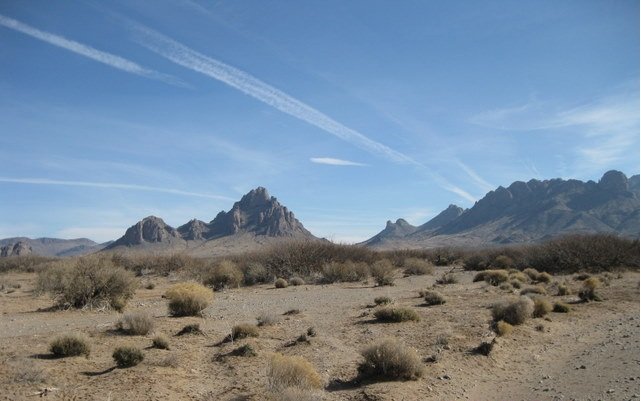 Facebook
Facebook
 X
X
 Instagram
Instagram
 TikTok
TikTok
 Youtube
Youtube

The last time a foreign military force invaded the continental United States was on March 9, 1916, when Pancho Villa's raiders sneaked over the Mexican border and attacked the small town of Columbus, New Mexico.
It was 4:11 a.m. that morning when one of the Villistas, as Pancho Villa's men were called, shot a bullet through the clock at the town's train depot. It wasn't the only bullet shot. For a few hours the 500 or so Villistas robbed the townspeople, burned their shops and shouted, "Viva Villa! Viva Mexico!"
The 13th U.S. Cavalry was stationed on the edge of Columbus, placed there to guard the border, yet they had been completely caught by surprise that morning. In fact, they were unable to defend themselves against the Villistas until they located the soldier with the keys to unlock their stored weapons.
Before the Villistas retreated south of the border, both townspeople and soldiers had died. Townspeople feared the Villistas would return to attack the next day, and some of them fled north to the nearby town of Deming. My great-grandfather was there, a boy of five years, and he remembers hiding from the Villistas in Deming's county courthouse.
I traveled to Deming and then down to Columbus, which is still a small and dusty town today surrounded by the cactus and scrub of the Chihuahuan Desert and some minor, rocky mountains.
As undeveloped as the area remains, in 1959 Pancho Villa State Park was dedicated on the site of the raid, and an unexpectedly well-stocked museum was built. Next to the museum is Coote's Peak, where U.S. soldiers stood watching out for another invasion, and where I looked down on the Mexican border and imagined Pancho Villa commanding his raiders.
The Villistas attacked for reasons that remain unclear to history. Pancho Villa aspired to power during Mexico's Revolution, and U.S. President Woodrow Wilson showed support for Villa's rival, Ernesto Carranza, so the incursion might have been revenge for Wilson's meddling.
But regardless, the U.S. military took the invasion seriously and sent General "Black Jack" Pershing to head a manhunt for Villa. (San Diego's Pershing Avenue is named after General Pershing.) This so-called Mexican Punitive Expedition comprised thousands of American troops and ultimately reached as far as 500 miles into Mexico.
But Pershing came back empty-handed. Pancho Villa thus became a symbol of rebellion. And for almost 100 years, no foreign military has been so bold as to attack the contiguous United States as when Pancho Villa and his men rode into the desert outpost of Columbus, New Mexico.


The last time a foreign military force invaded the continental United States was on March 9, 1916, when Pancho Villa's raiders sneaked over the Mexican border and attacked the small town of Columbus, New Mexico.
It was 4:11 a.m. that morning when one of the Villistas, as Pancho Villa's men were called, shot a bullet through the clock at the town's train depot. It wasn't the only bullet shot. For a few hours the 500 or so Villistas robbed the townspeople, burned their shops and shouted, "Viva Villa! Viva Mexico!"
The 13th U.S. Cavalry was stationed on the edge of Columbus, placed there to guard the border, yet they had been completely caught by surprise that morning. In fact, they were unable to defend themselves against the Villistas until they located the soldier with the keys to unlock their stored weapons.
Before the Villistas retreated south of the border, both townspeople and soldiers had died. Townspeople feared the Villistas would return to attack the next day, and some of them fled north to the nearby town of Deming. My great-grandfather was there, a boy of five years, and he remembers hiding from the Villistas in Deming's county courthouse.
I traveled to Deming and then down to Columbus, which is still a small and dusty town today surrounded by the cactus and scrub of the Chihuahuan Desert and some minor, rocky mountains.
As undeveloped as the area remains, in 1959 Pancho Villa State Park was dedicated on the site of the raid, and an unexpectedly well-stocked museum was built. Next to the museum is Coote's Peak, where U.S. soldiers stood watching out for another invasion, and where I looked down on the Mexican border and imagined Pancho Villa commanding his raiders.
The Villistas attacked for reasons that remain unclear to history. Pancho Villa aspired to power during Mexico's Revolution, and U.S. President Woodrow Wilson showed support for Villa's rival, Ernesto Carranza, so the incursion might have been revenge for Wilson's meddling.
But regardless, the U.S. military took the invasion seriously and sent General "Black Jack" Pershing to head a manhunt for Villa. (San Diego's Pershing Avenue is named after General Pershing.) This so-called Mexican Punitive Expedition comprised thousands of American troops and ultimately reached as far as 500 miles into Mexico.
But Pershing came back empty-handed. Pancho Villa thus became a symbol of rebellion. And for almost 100 years, no foreign military has been so bold as to attack the contiguous United States as when Pancho Villa and his men rode into the desert outpost of Columbus, New Mexico.